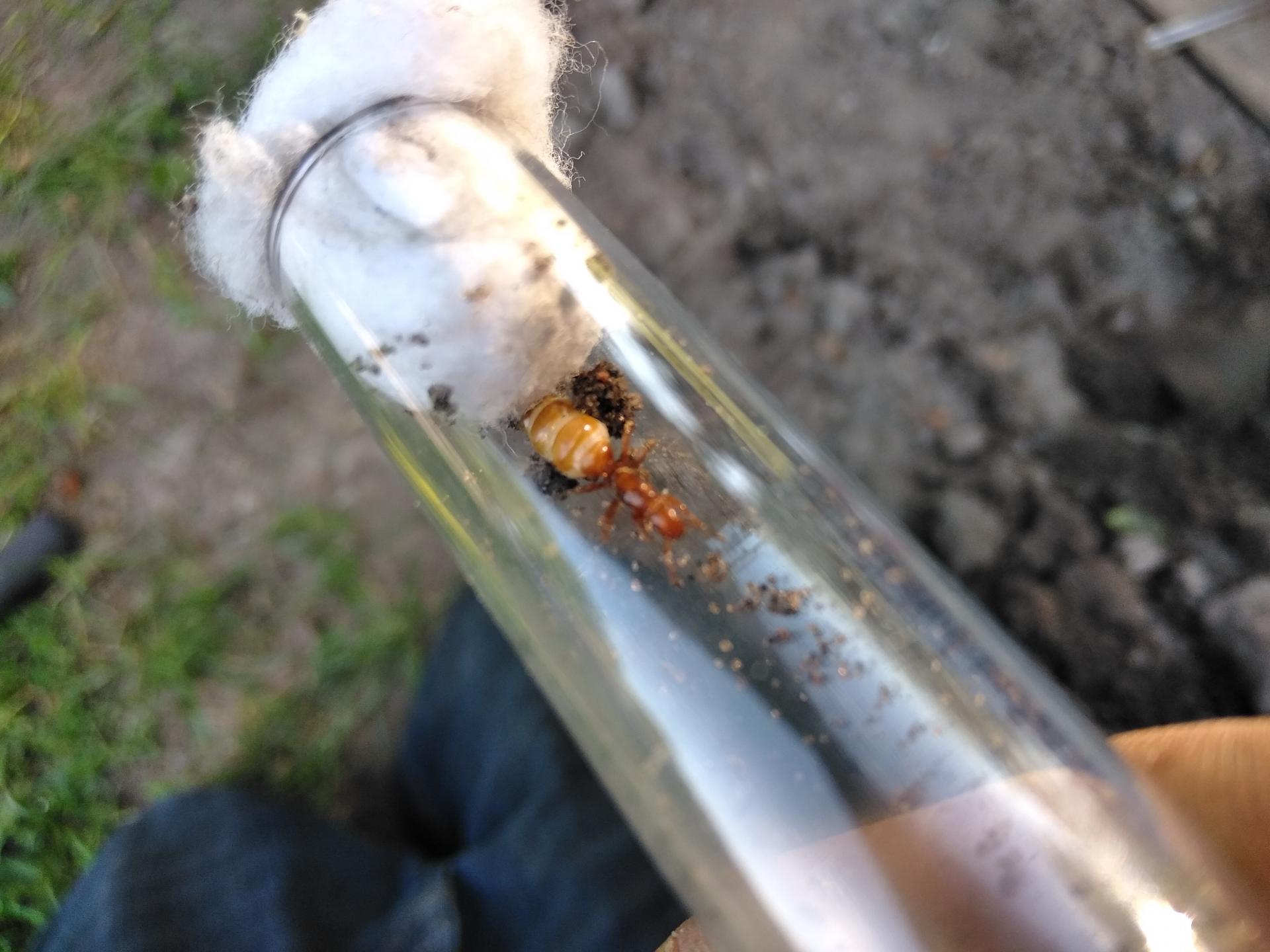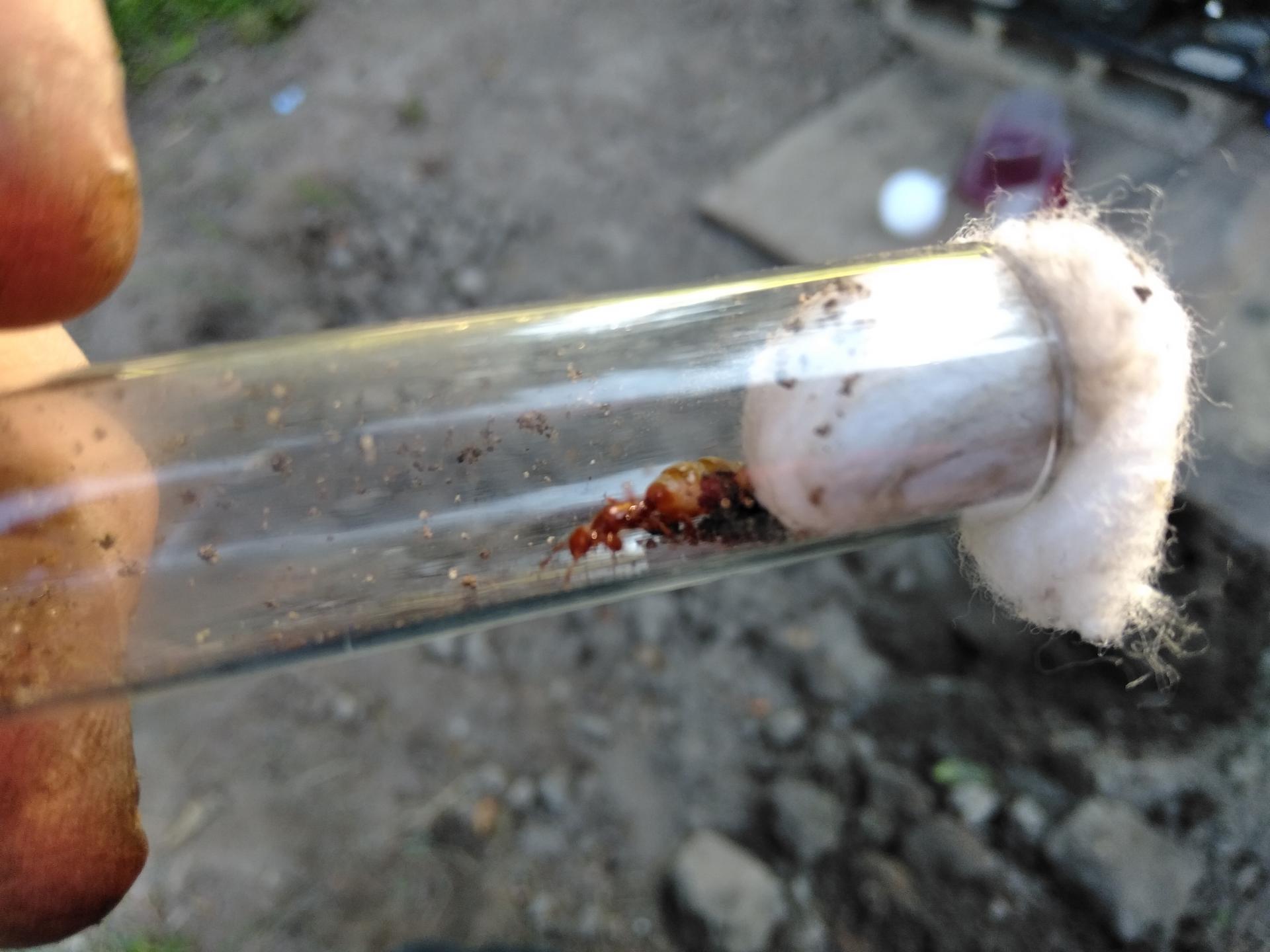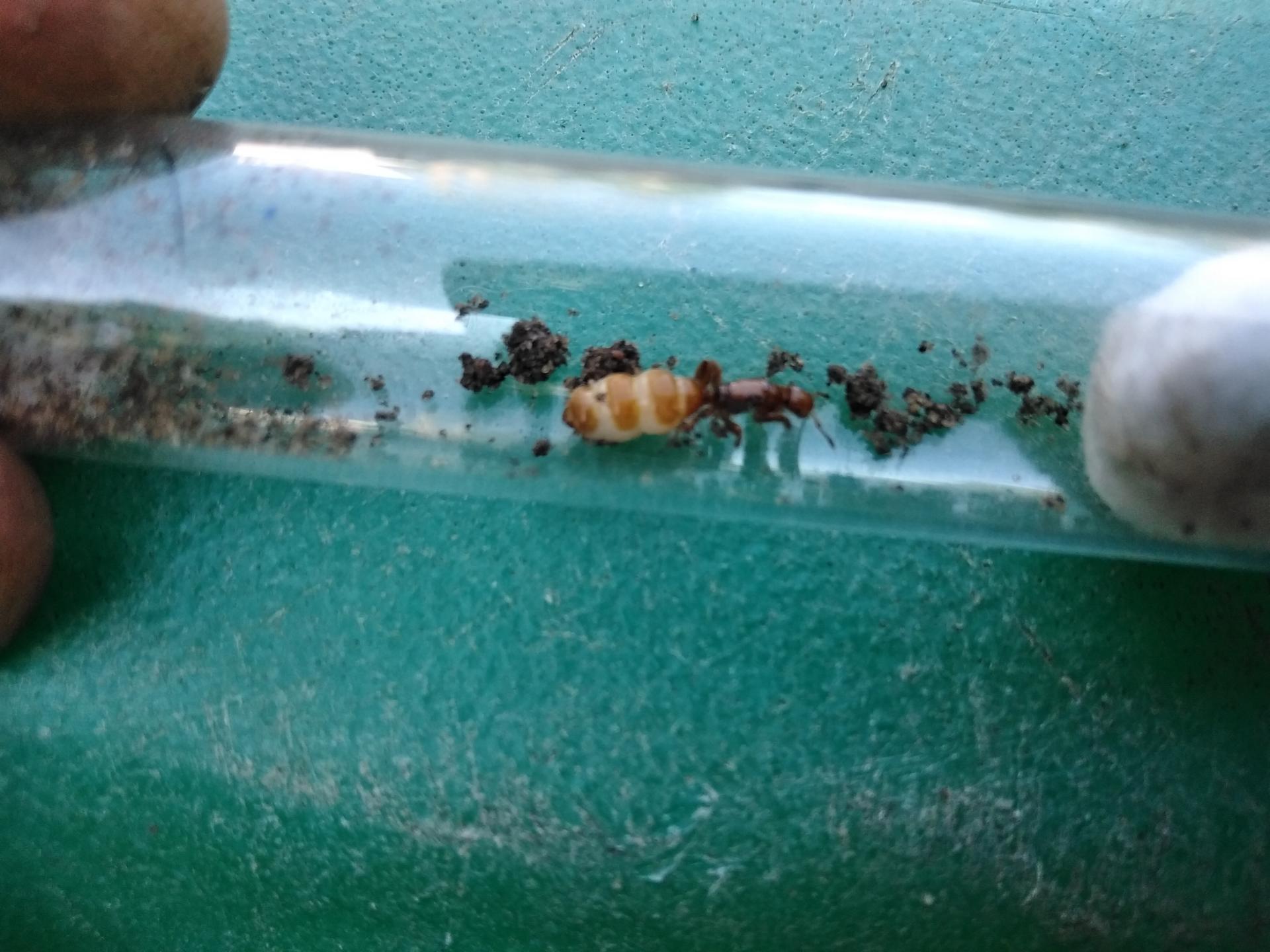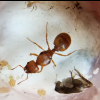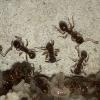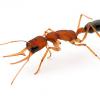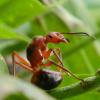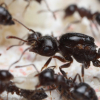- Formiculture.com
- Forums
- Gallery
- Members
- Member Map
- Chat
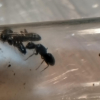
Is this even an ant.
Started By
AntJohnny
, Jun 15 2020 2:50 PM
16 replies to this topic
#1
 Offline
-
Posted June 15 2020 - 2:50 PM
Offline
-
Posted June 15 2020 - 2:50 PM
I was digging up my garden and found this. I have no clue if it is even an ant or a termite or what. I live in Michigan and have never seen a bug like this.
- AnthonyP163, Antennal_Scrobe and RushmoreAnts like this
#2
 Offline
-
Posted June 15 2020 - 2:52 PM
Offline
-
Posted June 15 2020 - 2:52 PM
Yes its an ant, looks like a parasitic Lasius queen.
Edited by Antkid12, June 15 2020 - 2:56 PM.
Ants I have: Tapinoma sessile(2 queen colony). RED MORPH Camponotus neacticus(now has pupae!), Tetramorium immigrans (x3), Aphaenogaster sp, Temnothorax sp, Brachymyrmex sp. possibly infertile ![]() , Ponera pennsylvanica, and Pheidole morrisi!
, Ponera pennsylvanica, and Pheidole morrisi! ![]()
Other insects: Polistes sp. Queen
Ants I need: Pheidole sp., Trachymyrmex sp., Crematogaster cerasi , Dorymyrmex sp. Most wanted: Pheidole morrisii
#3
 Offline
-
Posted June 15 2020 - 2:59 PM
Offline
-
Posted June 15 2020 - 2:59 PM
I didn't see any lasious by her. But even any eggs. I only pulled out a small shovel off dirt while I was weeding. She can't even move herself. Idk if I should drop her by where I found her or see if I can find her brood and workers. She is really cool looking.
- Antkid12 likes this
#4
 Offline
-
Posted June 15 2020 - 3:03 PM
Offline
-
Posted June 15 2020 - 3:03 PM
It's a Lasius latipes queen I believe.
- CheetoLord02 and Antkid12 like this
Currently keeping:
Tetramorium immigrans, Pogonomyrmex occidentalis
Myrmica punctiventris, Formica subsericea
Formica pallidefulva, Aphaeogaster cf. rudis
Camponotus pennsylvanicus
Camponotus nearcticus
Crematogaster cerasi
Temnothorax ambiguus
Prenolepis imparis
#5
 Offline
-
Posted June 15 2020 - 3:12 PM
Offline
-
Posted June 15 2020 - 3:12 PM
It's a Lasius latipes queen I believe.
I agree.
Edited by Antkid12, June 15 2020 - 3:13 PM.
- Antennal_Scrobe likes this
Ants I have: Tapinoma sessile(2 queen colony). RED MORPH Camponotus neacticus(now has pupae!), Tetramorium immigrans (x3), Aphaenogaster sp, Temnothorax sp, Brachymyrmex sp. possibly infertile ![]() , Ponera pennsylvanica, and Pheidole morrisi!
, Ponera pennsylvanica, and Pheidole morrisi! ![]()
Other insects: Polistes sp. Queen
Ants I need: Pheidole sp., Trachymyrmex sp., Crematogaster cerasi , Dorymyrmex sp. Most wanted: Pheidole morrisii
#6
 Offline
-
Posted June 15 2020 - 3:26 PM
Offline
-
Posted June 15 2020 - 3:26 PM
I found the workers. They smell just like citernello ants. But yeah the queen looks nothing like a citernello queen.
#7
 Offline
-
Posted June 15 2020 - 3:38 PM
Offline
-
Posted June 15 2020 - 3:38 PM
This queen looks very physogastric.
- CheetoLord02, Antennal_Scrobe and Antkid12 like this
#8
 Offline
-
Posted June 15 2020 - 3:51 PM
Offline
-
Posted June 15 2020 - 3:51 PM
That’s one thick queen.
- Antennal_Scrobe, Antkid12 and Vodach like this
"The ants are a people not strong, yet they prepare their meat in the summer." Prov. 30:25
Keep ordinary ants in extraordinary ways.
Keep ordinary ants in extraordinary ways.
#9
 Offline
-
Posted June 15 2020 - 4:31 PM
Offline
-
Posted June 15 2020 - 4:31 PM
Jeez, she's fat.
- Antkid12 likes this
#10
 Offline
-
Posted June 15 2020 - 4:48 PM
Offline
-
Posted June 15 2020 - 4:48 PM
I let her go back where I found her. Her workers got her back underground. I really hope she fits through the tunnels without being ripped in half.
#11
 Offline
-
Posted June 15 2020 - 6:14 PM
Offline
-
Posted June 15 2020 - 6:14 PM
I let her go back where I found her. Her workers got her back underground. I really hope she fits through the tunnels without being ripped in half.
Shoudl have just kept her. The workers will likely end up ripping her apart trying to get her through the tunnels. I've had this happen with fat queens before.
- RushmoreAnts likes this
#12
 Offline
-
Posted June 15 2020 - 7:01 PM
Offline
-
Posted June 15 2020 - 7:01 PM
You should’ve collected some workers to go with her. I’d give a pretty penny to get my hands on a queen of that species, especially a physogastric one like that.
- FSTP likes this
"God made..... all the creatures that move along the ground according to their kinds (including ants). And God saw that it was good. Genesis 1:25 NIV version
Keeping:
Formica cf. pallidefulva, cf. incerta, cf. argentea
Formica cf. aserva, cf. subintegra
Myrmica sp.
Lasius neoniger, brevicornis
#13
 Offline
-
Posted June 15 2020 - 7:03 PM
Offline
-
Posted June 15 2020 - 7:03 PM
You should’ve collected some workers to go with her. I’d give a pretty penny to get my hands on a queen of that species, especially a physogastric one like that.
For get a pretty penny, I'd give give (that is a double giving) my bottom dollar for a fat queen like that!
- RushmoreAnts likes this
#14
 Offline
-
Posted June 15 2020 - 7:06 PM
Offline
-
Posted June 15 2020 - 7:06 PM
The thing is, though, she might be pretty old.You should’ve collected some workers to go with her. I’d give a pretty penny to get my hands on a queen of that species, especially a physogastric one like that.
For get a pretty penny, I'd give give (that is a double giving) my bottom dollar for a fat queen like that!
"God made..... all the creatures that move along the ground according to their kinds (including ants). And God saw that it was good. Genesis 1:25 NIV version
Keeping:
Formica cf. pallidefulva, cf. incerta, cf. argentea
Formica cf. aserva, cf. subintegra
Myrmica sp.
Lasius neoniger, brevicornis
#15
 Offline
-
Posted June 16 2020 - 1:20 AM
Offline
-
Posted June 16 2020 - 1:20 AM
I really wanted to keep her. Although alot of the wild colonies in my yard have winged Queens and males in there nests right now. I don't know there nuptial flight dates in the year but hopefully she will add more. I have had alot of really good luck finding queen in my front garden. Last year I found a slave raiding queen. Sadly she didn't make it and I regretted keeping her in case it was my fault she died.
#16
 Offline
-
Posted June 16 2020 - 1:23 AM
Offline
-
Posted June 16 2020 - 1:23 AM
Physogastric Queens only stay like that in the main part of there egg laying season don't they. Or do they stay like that once they enlarge. I don't know much about that. I think I remember reading something about it a few years ago saying it has something to do with there ovaries. But I am probably way off.
#17
 Offline
-
Posted June 16 2020 - 12:57 PM
Offline
-
Posted June 16 2020 - 12:57 PM
I let her go back where I found her. Her workers got her back underground. I really hope she fits through the tunnels without being ripped in half.
Shoudl have just kept her. The workers will likely end up ripping her apart trying to get her through the tunnels. I've had this happen with fat queens before.
This is kinda a terrible idea, these queens can live for 26+ years (probably more like 30-35) and its possible she is already a decade or more in age. Removing this queen (from a mature colony consisting tens of thousands of workers) reduces the reproductive ability of this sp in the area. Removing here would likely actually damage the population, unlike removing an aphaenogaster colony.
You should’ve collected some workers to go with her. I’d give a pretty penny to get my hands on a queen of that species, especially a physogastric one like that.
Keeping a queen like this alive would require capturing a ton of workers and even then the captured portion of the colony would likely die. Starting this sp from a queen and hosts is a much better option.
Physogastric Queens only stay like that in the main part of there egg laying season don't they. Or do they stay like that once they enlarge. I don't know much about that. I think I remember reading something about it a few years ago saying it has something to do with there ovaries. But I am probably way off.
These queens, once they get to this size, are laying hundreds if not thousands of eggs a day. They can "deflate" a fair bit but its not going to be instant nor is it going to be fully back to fresh dealate size.
Edited by Otter, June 16 2020 - 12:58 PM.
- AnthonyP163, ANTdrew, RushmoreAnts and 3 others like this
Check out my Youtube!
https://www.youtube....ohUZtcyttLctSwA
I also have an Antstagram
https://www.instagra...otters_inverts/
1 user(s) are reading this topic
0 members, 1 guests, 0 anonymous users



